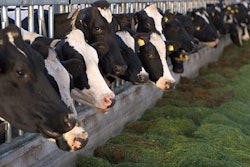
As cost increases with further processing, it is important to know the pros and cons of each type of piglet feed.
Pellets, meal (mash) or crumbles? To process or not to process, this is the question, and there is simply no single answer.
I recall the same formula prepared in the same feed plant sent to one country and piglets always scoured when pelleted, so we had to have the feed in meal form. Yet, in the next country, the exact same formula in meal form always caused scours, so we had to pellet it. Real story, no explanation – at least from the nutritional point of view – as I was responsible for the formula and oversaw ingredient procurement and production at the plant. The answer is on the health status of the piglets which can be vastly different. But, this example from my work helps illustrate that sometimes one form or the other is preferable.
But, before I share my experience on when to use one form versus the other, allow me to present the benefits of each form of feed (which, as it happens are the disadvantages of the other forms).
-
Meal
- Least expensive as it involves no further processing beyond mixing
- Can be made with coarser grains for specific health issues
- Farms can add specific medications if they have a home mixer
- Can be consumed easily by very young piglets with sensitive mouth lining
-
Pellets
- Nutrients are more digestible due to thermal processing, unless overheated
- Less dust ensuring healthier air quality for humans and animals
- Feeds can be of finer particle size as they do not get stuck in silos and feeders
- Unmixing of ingredients is avoided, ensuring consistent nutrient intake
-
Crumbles
- Best (and worst) of pellets and meal at an extra cost
- Helps in marketing to create brand identity
- Best solution when soft pellets cannot be made
- Piglets have a taste for different texture
Common observations
These are some of the main benefits of each form. In general, home-mixers prefer a meal-type feed because they do not want to invest in or operate a pellet machine. Those that buy complete piglet feeds go for pellets when they buy quality (expensive) products because there is this erroneous notion in the market that pellets are always quality products. Finally, there are those who tried both and ended up using crumbles as they find them best suited for their farms. After all, the first couple of feeds – or even only the first feed post-weaning – for which we discuss here cost no more than a couple of dollars per pig (at worst-case scenario) to buy and feed, and the difference between one form or the other is minimal. This is an example based on a per-pig basis and in huge farms where cents count, such difference may not make sense if there is no difference between one form or the other.
Common knowledge indicates that healthy pigs consuming pellets will outperform those that consume meal by 0 to 15%, taking 10% as the golden rule. With this number in mind, one can easily calculate if it is financially advantageous to use pellets over meal. Such observations are not available for crumbles, but it is safe to assume the same rule apples as the majority of response comes (presumably) from the thermal processing of ingredients that makes them more digestible. This latter aspect increases feed intake as has been unequivocally demonstrated long ago. The positive response to pellets diminishes quickly, and by the time pigs exit the nursery (at 20-30 kg body weight) the benefit is 0 to 5%, depending on formula composition.
When to use meal
When liquidity is an issue, one has to opt for the less expensive solution. Others prefer the least expensive solution up front, by conviction, as they are not believers in investing in accelerating piglet growth. So, meal and cost are closely associated for one reason or the other. In unhealthy pigs, or those raised in less-than-ideal conditions, or those expected to break out with a digestive disease or disorder, practical experience has clearly demonstrated that meal is the way to go. In fact, not only is meal the preferred form of feed, but coarse feed is even more important. Thus, meal composed of coarsely ground cereals is strongly recommended for unhealthy pigs. This reduces their potential for growth, but also reduces the impact of digestive diseases. And it is not like these pigs were going to grow more if they were given pellets, as they were going to get sick anyway. It is best to resolve the issues of health first, but this is not always feasible, possible or even desirable due to cost.
When to use pellets
Healthy pigs thrive on pellets, but they like to play with them if offered in the maternity area. So, in that case, too, meal is preferred. But, otherwise, well-made, soft pellets are always preferable because the pigs can consume more nutrients per given volume of feed due to compaction, and the extra cooking of ingredients also offers its own benefits as described above. Pellets also are great when feeds are handled in bulk as early feeds are rich in milk products that are sticky and tend to create blockages in silos and feeders. Pellets are also the preferred form for feeds that are exported, again because good quality commercial feeds are associated with pellets. Pellets help manufacturers that possess such equipment to differentiate their brands from others that cannot afford the pelleting machinery.

















